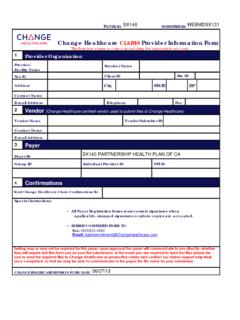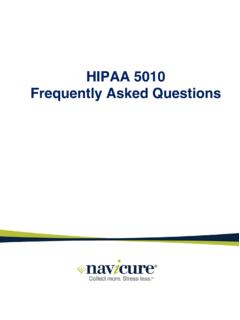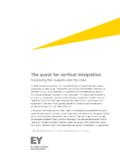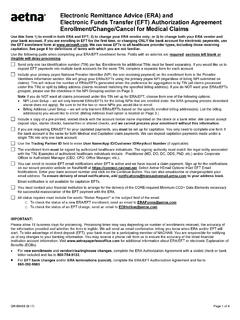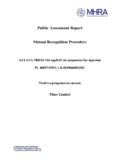Transcription of AWS Genomics WP - d1.awsstatic.com
1 AWS Genomics Guide August 2017 2017, Amazon Web Services, Inc. or its affiliates. All rights reserved. Notices This document is provided for informational purposes only. It represents AWS s current product offerings and practices as of the date of issue of this document, which are subject to change without notice. Customers are responsible for making their own independent assessment of the information in this document and any use of AWS s products or services, each of which is provided as is without warranty of any kind, whether express or implied. This document does not create any warranties, representations, contractual commitments, conditions or assurances from AWS, its affiliates, suppliers or licensors. The responsibilities and liabilities of AWS to its customers are controlled by AWS agreements, and this document is not part of, nor does it modify, any agreement between AWS and its customers. Contents Introduction 1 AWS Value Proposition for Genomics 1 Compliance and Security 2 Classifying data for compliance requirements 2 Deploy AWS environment to meet your needs 4 Access Management 5 Genomics on AWS 6 Analysis Stages in Genomics 6 Analysis of Genomic Data on AWS 7 Processing 15 Sharing 27 Public Datasets 28 Conclusion 29 Document Revisions 30 Abstract This whitepaper focuses on common strategies and best practices used successfully by Amazon Web Services (AWS) customers for analyzing Genomics sequencing data and associated medical datasets.
2 For more information regarding specific customer use cases, please refer to our customer Healthcare and Life Sciences Web Portal. Our intention is to provide you with helpful guidance that you can use to facilitate your Genomics initiatives using AWS services and features. However, we caution you not to rely on this whitepaper as legal advice for your specific use of AWS. We strongly encourage you to obtain appropriate compliance advice about your specific data privacy and security requirements, as well as applicable laws relevant to your human research projects and datasets. Amazon Web Services Paper Title Page 1 Introduction Welcome to the AWS Genomics User Guide! Whether you are just getting started or have already been analyzing Genomics data using the AWS Cloud, we hope that the AWS Genomics User Guide will provide you with some of the 'know-how' information that you need in order to use our services and features in the ways that will make the most sense for your data analytical objectives.
3 Let us solve the mysteries of how to leverage the right resources for your Genomics data processing and analytics jobs so that you can solve the mysteries surrounding health, disease, and evolution. AWS Value Proposition for Genomics AWS provides multiple advantages for building scalable, cost effective and secure genomic analysis pipelines. Here are some key advantages of using AWS for analysis in general that we will be providing a deeper dive discussion of in the following sections of this whitepaper: Genomics secondary-stage analysis pipelines are typically executed in cohort or batch workloads. As a result, infrastructure is only required for the time needed to execute the compute job. AWS provides elasticity to quick scale up or down and hence saves on infrastructure costs. Storing Genomics and Medical ( imaging) data at different stages requires enormous storage in a cost-effective manner. Amazon Simple Storage Service (Amazon S3), Amazon Glacier and Amazon Elastics Block Store (Amazon EBS) provide the necessary solutions to securely store, manage and scale genomic file storage.
4 Moreover, the storage services can interface with various compute services from AWS to process these files. AWS provides a wide choice of compute services that can be used to process diverse datasets in analysis pipelines. These range from managed services to virtual servers that can be combined with flexible purchasing options consisting of on demand, reserved and spot. Genomic sequencers that generate raw data files are located in labs on premises and AWS provides solutions to make it easy for customers to transfer these files to AWS reliably and securely. Amazon Web Services Paper Title Page 2 As of 07/31/2017, AWS has 16 regions, 43 availability zones and 77 edge locations across the globe. This number is continuously growing. Using this elaborate network of AWS points of presences, customers can build a secure platform to collaborate on research findings as a result of analyzing genomic and associated medical data sets. The AWS Partner Network has a vast ecosystem of independent software vendors (ISVs) and systems integrators (SIs) with domain expertise and products that are applicable for Genomics workloads.
5 The AWS Marketplace also includes a Healthcare & Life Sciences Industry vertical category that offers a broad range of solutions from 3rd party providers. Solutions include technical Research & Development focused applications, as well as solutions for managing Healthcare and Life Sciences related organizational operations. Compliance and Security Security is job number one at AWS and we recommend prior to working with potentially sensitive data on AWS that you take the time to understand the security and compliance requirements surrounding it. A typical workflow for addressing compliance needs is as follows: 1. Classify data to determine necessary access controls and security requirements 2. Align AWS architectures and standard operating procedures to a compliance framework 3. Deploy AWS environment and controls that meet compliance requirements 4. Deploy data and applications on top of the AWS environment Classifying data for compliance requirements AWS operates under a shared security responsibility model, where AWS is responsible for the security of the underlying cloud infrastructure and you are responsible for securing workloads and data you deploy in AWS.
6 AWS does not Amazon Web Services Paper Title Page 3 access or use customer content for any purpose other than as legally required and to provide the AWS services selected by each customer, to that customer and its end users. AWS never uses customer content or derives information from it for other purposes such as marketing or advertising. The implication of the above is that is that you, as the data owner, will need to classify data to fit within the spectrum encompassing public domain through to Protected Health Information (PHI). Figure 1 shows a practical example of data classification for genomic sequence data. The spectrum of data classification for security and compliance. Genome-in-a-Bottle data are in the public domain; gnomAD, ERA, and SRA release some data within the public domain, but restrict access to individual genomes; all Framingham data restricted access for research use; finally, a cancer gene panel that is produced in the service of making treatment decisions would typically fall under regulatory requirements for Protected Health Information (PHI).
7 At the most basic level, AWS recommends following the guidelines within the AWS Security Best Practices documentation. When working with sensitive data, AWS recommends following security by design principles such as encrypting data in transit and at rest, securing network accessible resources, and robust logging of operations on data and compute resources. Aligning and documenting your operating procedures for management of data and compute resources to a recognized security and compliance framework, such as NIST 800-171, will provide the necessary controls for protecting the data. Doing so will also allow you to quickly onboard other sensitive data, since you are able to leverage the same templated infrastructure and operating procedures. More information on security by design is available in the Security by Design principles whitepaper. For healthcare data that are considered PHI, all storage and analysis services will likely fall under the geography s regulation where the data resides.
8 For the United States, that would be the Health Information Portability and Accountability Act (HIPAA). If you classify some portions of your data and Genomics as PHI, then HIPAA regulations will need to be met. There is no Amazon Web Services Paper Title Page 4 HIPAA certification for a cloud provider such as AWS. In order to meet the HIPAA requirements applicable to our operating model, AWS aligns our HIPAA risk management program with FedRAMP and NIST 800-53, a higher security standard that maps to the HIPAA security rule. NIST supports this alignment and has issued SP 800-66, "An Introductory Resource Guide for Implementing the HIPAA Security Rule," which documents how NIST 800-53 aligns to the HIPAA Security rule. Following our guidance above to align your compliance and security practices to a compliance framework will go a long way towards deploying HIPAA Eligible applications stacks. Additionally, AWS would be considered your "business associate" and require that a contractual agreement be countersigned by a covered entity and AWS.
9 This agreement is referred to as the Business Associate Agreement (BAA). The agreement outlines the AWS services and features that are HIPAA-eligible, and any constraints on these services that are necessary to meet compliance regulations. For example, Amazon S3 is a HIPAA-eligible service, but the BAA stipulates that any that you have determined is PHI must only be encrypted in transit and at rest, and that S3 event logs must be captured for a determined period to allow for forensic analysis in the event of a data breach. For more detailed information regarding HIPAA compliance and the AWS BAA, please refer to our website. In many cases, customers are also able to use non-HIPAA eligible services and features in their architecture by first implementing a process to de-identify any sensitive data prior to processing. Doing so would allow the de-identified data to be processed through an analytical resource that are not currently listed as part of the BAA ( Amazon EFS, Amazon IoT).
10 Covered services ( Amazon RDS, Amazon DynamoDB) would maintain the PHI metadata, perhaps by establishing an arbitrary key-value mapping protocol, so that the de-identified results can later be re-associated with PHI. De-identification should be done in accordance with the BAA and as outlined by the Department of Health & Human Services guidelines for methods of De-Identification. Deploy AWS environment to meet your needs In order to meet the identified security controls for data and resources, we recommend that you align your systems and procedures to a security and compliance framework, such as NIST SP 800-171. Adopting and documenting a standard set of controls for the AWS resources, applications, and users to form a set of standard operating procedures is relatively straight forward, but does require some attention. To help with development and documentation of compliant system, AWS has developed a set of Quick Start enterprise accelerator Amazon Web Services Paper Title Page 5 packages.











